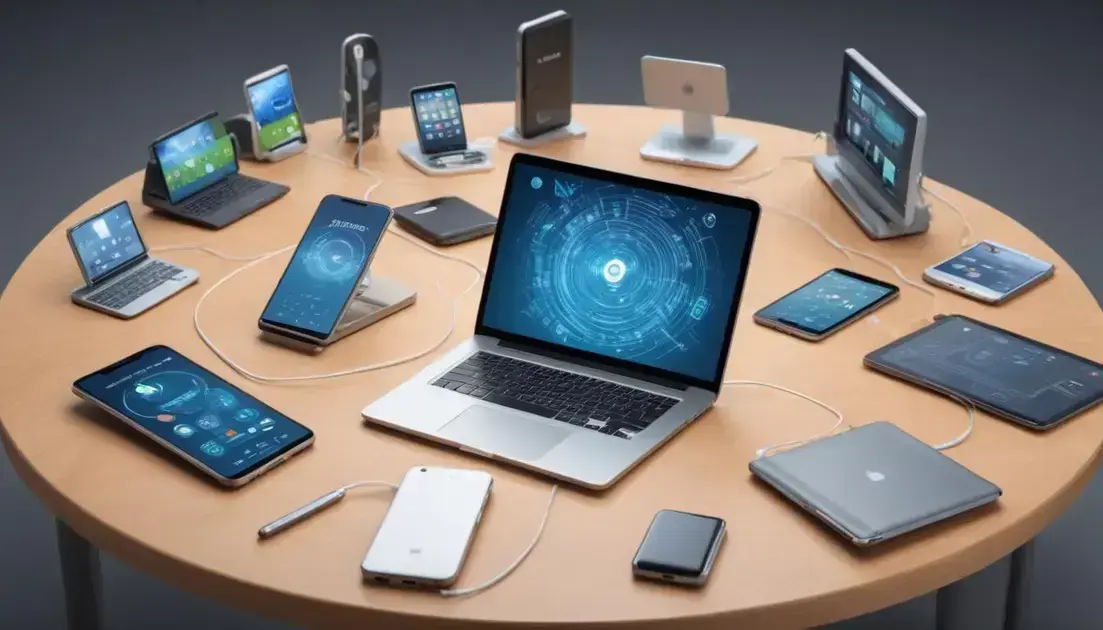How refurbished technology is transforming telco sustainability
Refurbished technology is a sustainable option that reduces electronic waste, offers cost-effective alternatives for consumers, and enhances brand reputation while meeting the growing demand for environmentally friendly products.
Refurbished tech is at the forefront of sustainability in the telecom industry. As demand grows, understanding its potential can lead to significant environmental benefits. What role does refurbishment play in reducing waste?
Introduction to refurbished tech in the telecom sector
The telecom sector is undergoing a significant transformation with the rise of refurbished technology. This approach not only promotes sustainability but also addresses the pressing issue of electronic waste. By reusing and refreshing devices, telecom companies can significantly extend the lifespan of their products.
Refurbished devices offer cost-effective solutions for consumers, allowing them to access high-quality technology without the premium price tag. This accessibility further encourages a broader audience to engage with sustainable practices, contributing to a circular economy.
Moreover, major telecom operators are leading the charge by integrating refurbished products into their offerings. This not only enhances their green credentials but also helps them meet regulatory requirements and consumer demand for environmentally responsible practices. The emphasis on refurbishment aligns with global trends toward sustainability, where companies are expected to minimize their carbon footprints.
As refurbishment gains traction, it encourages innovation in repair processes and enhances the overall quality of devices entering the market. The focus on sustainability helps foster a culture of awareness about responsible consumption, urging consumers to reconsider their buying habits. This shift is vital for the future of technology and its role in our daily lives.
The role of circular economy in sustainability
The circular economy is a crucial element in advancing sustainability within various sectors, particularly in technology. Unlike the traditional linear model of production and disposal, the circular economy emphasizes resource efficiency and waste reduction. This model promotes the reuse, refurbishment, and recycling of materials, which significantly lessens environmental impact.
Incorporating the circular economy into business practices allows companies to extend the life cycle of their products. By designing devices for durability and reusability, businesses can reduce resource consumption and minimize energy use. This approach not only benefits the planet but also offers economic advantages by lowering material costs over time.
Moreover, the circular economy fosters innovation. Companies are encouraged to develop new technologies and business models that support sustainable practices. For instance, the rise of refurbished technology showcases how businesses can create value from what was once considered waste.
Consumer engagement is also vital in this shift. As awareness of sustainability grows, consumers increasingly prefer companies that practice the circular economy. This trend pushes businesses to adopt more responsible practices, further driving the global agenda toward sustainability and reducing waste. Ultimately, the circular economy is not just a trend; it is becoming a fundamental aspect of how industries must operate in the future.
Matt Manning’s insights on BT Group’s strategies
Matt Manning offers insightful perspectives on BT Group’s strategies regarding sustainability and refurbished technology. According to him, embracing a circular economy is essential for minimizing waste and enhancing overall sustainability. This approach not only helps the environment but also positions BT Group as a leader in responsible business practices.
He emphasizes the importance of consumer trust. By prioritizing refurbished devices, BT Group can build stronger relationships with its customers. This strategy appeals to environmentally conscious consumers who seek brands that demonstrate genuine investment in sustainability.
Manning also highlights that integrating circular economy principles into BT Group’s operations can drive innovation. This includes developing new refurbishment processes that ensure high-quality standards for used devices. By innovating in this space, BT Group can offer competitive products while reducing its carbon footprint.
Furthermore, Manning notes that adopting sustainable practices is becoming increasingly crucial not just for corporate responsibility, but also for long-term profitability. As market demands shift towards greener solutions, BT Group’s strategies can secure a sustainable future, benefiting both the company and the broader community.
Consumer attitudes towards refurbished devices
Consumer attitudes towards refurbished devices are evolving, with an increasing number of people recognizing their value. Many consumers now understand that refurbished products can offer high quality at a lower price compared to brand-new items. This shift implies a growing confidence in the refurbishing process and the quality control measures in place.
Research shows that buyers are becoming more environmentally conscious, prompting them to opt for refurbished devices as a sustainable choice. This choice not only reduces electronic waste but also minimizes the demand for new resources. As a result, eco-friendly consumers are likely to favor brands that support refurbished technology.
Moreover, consumers are influenced by the economic advantages of refurbished products. With rising costs, many individuals seek out cost-effective solutions without sacrificing quality. Brands that effectively communicate the benefits of their refurbished offerings often see improved sales and customer loyalty.
However, despite positive trends, some misconceptions persist. Consumers may still question the reliability and longevity of refurbished devices. Therefore, brands must prioritize transparency about their refurbishment processes and offer warranties to build trust. Addressing these concerns can further enhance consumer acceptance and drive the market for refurbished technology.
Challenges and opportunities in the telco industry
The telco industry faces a myriad of challenges and opportunities in the current landscape. One significant challenge is the rapid pace of technological change. Companies must continuously innovate to keep up with advancements such as 5G and IoT. This requires substantial investment in infrastructure and research.
Moreover, regulatory pressures and market competition are immense. Telecom operators are often compelled to comply with stringent regulations while maintaining competitive pricing. Balancing these demands can strain resources and complicate decision-making.
However, these challenges also present opportunities. The shift towards a more digital and connected world opens new revenue streams. For instance, companies can capitalize on the demand for refurbished devices as consumers increasingly seek sustainable solutions. By integrating refurbished products, telcos can enhance their green credentials and attract environmentally-conscious customers.
Furthermore, partnerships with tech innovators can drive growth. Collaborating with startups focused on emerging technologies enables telcos to stay ahead of trends and deliver improved services. Embracing a customer-centric approach also allows telecom companies to build loyalty and a positive brand image.
Ultimately, while the telco industry grapples with various hurdles, the evolving landscape also fosters numerous opportunities for growth and sustainability.
The future of refurbished technology and sustainability
The future of refurbished technology is intertwined with sustainability, and it is poised to play a significant role in shaping our digital landscape. As consumers become increasingly eco-conscious, the demand for refurbished devices is expected to surge. Businesses that prioritize sustainability in their offerings will likely see a competitive advantage.
Technological advancements are enhancing the efficiency of refurbishment processes. Improvements in diagnostics and repair techniques ensure that refurbished devices can meet high standards of performance and reliability. As a result, consumers are more inclined to purchase these products, viewing them as both cost-effective and environmentally friendly.
The circular economy model further supports the growth of refurbished technology. By emphasizing reuse and recycling, companies can contribute to reducing electronic waste. This approach not only benefits the planet but also aligns with regulatory trends favoring sustainable practices.
Moreover, innovation in marketing strategies can boost consumer awareness of the benefits of refurbished technology. Educating consumers about the positive environmental impacts and potential savings can drive higher adoption rates. As the conversation surrounding sustainability continues to evolve, refurbished technology is set to become a prominent element in the telecom industry and beyond.
Conclusion and key takeaways
The ongoing evolution of the telecommunications industry reinforces the importance of integrating sustainability into business practices. Companies must focus on strategies that promote the use of refurbished technology, which plays a critical role in reducing electronic waste and supporting a circular economy.
Key takeaways from this discussion highlight that consumer demand for sustainable options is growing. As awareness increases, businesses that adapt their offerings to include refurbished devices not only cater to this demand but also enhance their brand reputation.
Moreover, embracing innovation in refurbishment processes ensures that these devices meet consumer expectations for quality and performance. Collaboration within the industry will further drive advancements, enabling telecom operators to remain competitive.
Finally, understanding and addressing consumer concerns about refurbished technology is essential for building trust. Effective communication about the benefits of refurbishment can significantly impact purchasing decisions.
In summary, embracing refurbished technology is key
As we move forward, it is clear that refurbished technology plays a vital role in creating a more sustainable future. By focusing on sustainable practices, businesses can reduce electronic waste and contribute to a healthier planet.
Consumers are increasingly looking for eco-friendly options. This shift in demand means that companies that prioritize refurbished products are not only meeting customer needs but also enhancing their brand image.
Moreover, innovation in refurbishment processes ensures that these products maintain high quality. By addressing consumer concerns and informing them about the benefits of refurbished devices, companies can build trust and loyalty.
In conclusion, the telecommunications industry has a great opportunity to lead in sustainability. Embracing refurbished technology is not just beneficial for the environment; it’s also a smart business strategy that can drive growth and customer satisfaction.
Frequently Asked Questions
What are the benefits of using refurbished technology?
Refurbished technology offers cost savings, high-quality performance, and supports environmental sustainability by reducing electronic waste.
How does refurbished technology impact sustainability?
It promotes a circular economy by encouraging the reuse and recycling of devices, thereby lowering the demand for new resources and minimizing waste.
Are refurbished devices reliable?
Yes, refurbished devices are thoroughly tested and repaired to meet quality standards, ensuring they function properly and have a long lifespan.
How can companies communicate the benefits of refurbished products to consumers?
Companies can effectively share benefits through educational marketing materials, social media campaigns, and transparent information about their refurbishment processes.
Is the market for refurbished technology growing?
Yes, consumer demand for affordable and sustainable product options is driving the growth of the refurbished technology market globally.
What steps do businesses take to ensure quality in refurbished devices?
Businesses implement comprehensive testing, offer warranties, and follow strict refurbishment standards to ensure quality and reliability in their products.






